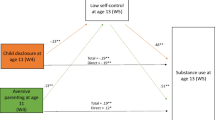Abstract
A series of studies are presented which examine the relation between parenthood intentions (intend to be a parent and intend to remain childless) and self-concept, mental health, and grade point average in a college student population. The results suggest that college students not intending to have a child tend to be statistically deviant on all the variables examined. Cross-validation results suggest a high frequency of psychopathology among the sample of young intended nonparent college students. Based on the MMPI results, the intention to be a nonparent appears to be associated with general maladjustment, rather than just a deviancy from social norms.
Similar content being viewed by others
References
Fitts, W. H. (1965).Tennessee Self Concept Scale Manual, Counselor Recording and Tests, Nashville, Tenn.
Goodbody, S. T. (1977). The psychosocial implications of voluntary childlessness.Soc. Casework 426–437.
Hathaway, S. R., and McKinley, J. C. (1951).The Minnesota Multiphasic Personality Inventory, Revised, Psychological Corporation, New York.
Hawk, S., and Peterson, R. A. (1974). Do MMPI psychopathic deviancy scores reflect psychopathic deviancy or just deviancy?J. Personal. Assess. 38: 362–368.
Kaltreider, N. B., and Margolis, A. G. (1977). Childless by choice: A clinical study.Am. J. Psychiat. 134: 179–182.
Kysar, J. E., Zaks, M. S., Schuchman, H. P., Schon, G. L., and Rogers, J. (1969). Range of Psychological function in “normal” late adolescents.Arch. Gen. Psychiat. 21: 515–528.
Lott, B. E. (1973). Who wants the children? Some relationships among attitudes toward children, parents, and the liberation of women.Am. Psychologist 28: 573–582.
Peterson, R. A. (1975). Change in college students' attitude toward child-bearing from 1971 to 1973.J. Personal. Assess. 39: 225–227.
Renne, K. S. (1977). Childlessness, health and marital satisfaction.Soc. Biol. 23: 183–197.
Silka, L., and Kiesler, S. (1977). Couples who choose to remain childless.Fam. Planning Perspect. 9: 16–25.
Van Dusen, R. A., and Sheldon, E. B. The changing status of American women: A life cycle perspective.Am. Psychologist 31: 106–116.
Veevers, J. E. (1972). The violation of fertility mores: Voluntary childlessness as deviant behavior. In Boydell, C., Trindstaff, C., and Whitehead, C., and (eds.),Deviant Behavior and Societal Reaction, Toronto: Holt, Rinehart and Winston, New York.
Veevers, J. E. (1973). The child-free alternative: Rejection of the motherhood mystique. In Stephenson, M. (ed.),Women in Canada, New Press, Toronto.
Author information
Authors and Affiliations
Additional information
Received his Ph.D. from the University of Iowa. Primary interest is parenting attitudes and parent training.
Rights and permissions
About this article
Cite this article
Peterson, R.A. Intended childlessness in late adolescence: Personality and psychopathology. J Youth Adolescence 9, 439–447 (1980). https://doi.org/10.1007/BF02087680
Received:
Issue Date:
DOI: https://doi.org/10.1007/BF02087680




